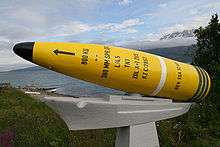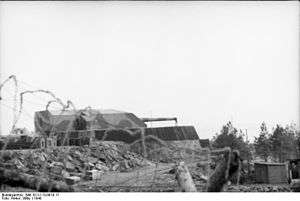38 cm SK C/34 naval gun
| 38 cm SK C/34 naval gun | |
|---|---|
|
38 cm turret of Batterie Vara, Kristiansand, Norway | |
| Type | Naval gun, Railroad gun and Coastal defense |
| Place of origin | Germany |
| Service history | |
| In service | 1940–45 |
| Used by | Nazi Germany |
| Wars | World War II |
| Production history | |
| Designer | Krupp |
| Designed | 1936—39 |
| Manufacturer | Krupp |
| Specifications | |
| Weight | 111 tonnes (109 long tons; 122 short tons) |
| Length | 19.63 m (64 ft 5 in) |
| Barrel length | 18.405 m (60 ft 4.6 in) L/48 |
|
| |
| Shell | separate-loading, case charge |
| Caliber | 380 millimetres (15 in) |
| Breech | horizontal sliding block |
| Recoil | hydro-pneumatic |
| Elevation | -5.5° to +30° |
| Traverse | up to 360° |
| Rate of fire | 2.5 rpm |
| Muzzle velocity | 820 m/s (2,700 ft/s) |
| Effective firing range | 36.5 km (22.7 mi) with 800 kg (1,800 lb) shell at 30° elev. |
The 38 cm SK C/34[Note 1] naval gun was developed by Germany mid to late 1930s. It armed the Bismarck-class battleships and was planned as the armament of the O-class battlecruisers and the re-armed Scharnhorst-class battleships. Six twin-gun mountings were also sold to the Soviet Union and it was planned to use them on the Kronshtadt-class battlecruisers, however they were never delivered. Spare guns were used as coastal artillery in Denmark, Norway and France. One gun is currently on display at Møvig Fortress outside Kristiansand.
Ammunition
It used the standard German naval system of ammunition where the base charge was held in a metallic cartridge case and supplemented by another charge in a silk bag. Both cartridges were rammed together.
Propellant charge[1]
Main charge: 38 cm HuelsKart34 -GefLdG- 108 kg (238 lb) RPC 38 (16/7)
Fore charge: 38 cm VorKart34 -GefLdG- 104 kg (229 lb) RPC 38 (16/7)
Shell

Four types of shells were used by the 38 cm SK C/34 although the Siegfried-Granate could only be used by the coast defense versions. Almost 40 per-cent lighter, this latter shell could be fired with a reduced charge at 920 metres per second (3,000 ft/s) to 40 kilometres (44,000 yd). With a full charge it reached 1,050 metres per second (3,400 ft/s) and could travel 55.7 kilometres (60,900 yd)–equivalent to over 34.5 miles.[2]
| Shell name | Weight | Filling Weight | Muzzle velocity | Range |
|---|---|---|---|---|
| nose-fused HE shell with ballistic cap (38 cm Spgr. L/4.6 m Kz (m.Hb) | 800 kg (1,800 lb) | Unknown | 820 m/s (2,700 ft/s) | 35.6 km (22.1 mi) at 30° |
| base-fused HE shell with ballistic cap (38 cm Spgr L/4.5 Bdz (m.Hb)) | 800 kg (1,800 lb) | Unknown | 820 m/s (2,700 ft/s) | 35.6 km (22.1 mi) at 30° |
| base-fused AP shell with a ballistic cap (Psgr L/4.4 BdZ (m.Hb)) | 800 kg (1,800 lb) | Unknown | 820 m/s (2,700 ft/s) | 35.6 km (22.1 mi) at 30° |
| nose- and base-fused HE shell with ballistic cap (Si-Gr L/4.5 Bdz u. Kz (m.Hb)) (light load) | 495 kg (1,091 lb) | 69 kg (152 lb) TNT | 920 m/s (3,000 ft/s) | 40.0 km (24.9 mi) |
| nose- and base-fused HE shell with ballistic cap (Si-Gr L/4.5 Bdz u. Kz (m.Hb)) (full load) | 495 kg (1,091 lb) | 69 kg (152 lb) TNT | 1,050 m/s (3,400 ft/s) | 55.7 km (34.6 mi) |
Naval gun
The data given is according to Krupp datasheet 38 cm S.K.C/34 e WA52-453(e). This gun was mounted in pairs in the Drh.L. C/34e turret which allowed elevation from -5° 30' to +30°.[3] Each gun had an individual cradle, spaced 3.5 metres (11 ft) apart, but they were normally coupled together. In general the turret was hydraulically powered, but the training gear, auxiliary elevation, auxiliary hoists and some loading gear was electrically powered. The turrets weighed 1,048 tonnes (1,031 long tons; 1,155 short tons) to 1,056 tonnes (1,039 long tons; 1,164 short tons),[4] rested on ball bearings on a 8.75 metres (28.7 ft) diameter track, could elevate 6° per second and traverse 5.4° per second. The guns were loaded at +2.5° and used a telescoping chain-operated rammer. According to German manuals [3] the required permanent capacity for the loading equipment for ammunition was 2.5 shells per minute. During testing period at the Baltic Sea the AVKS Report states an output of the ammunition delivery system up to 3.125 shells per minute.[5] Under battle conditions Bismarck averaged roughly one round per minute in her battle with HMS Hood and Prince of Wales.[6]
Turret armor
| location | thickness | location | thickness |
|---|---|---|---|
| face | 36 cm (14 in) | front and rear sloping roof | 18 cm (7.1 in) |
| sides | 22 cm (8.7 in) | side sloping roof | 15 cm (5.9 in) |
| rear | 32 cm (13 in) | flat roof | 13 cm (5.1 in) |
Numbers
Sixteen guns were used for the Bismarck and Tirpitz and six were ordered for the Gneisenau when it was to be re-armed in 1942. Six were intended for each of the O-class battlecruisers, but it is uncertain how many of these last were actually delivered. Six mountings with twelve guns were sold to the Soviet Union who planned to use them on two Kronshtadt-class battlecruisers, but these were never delivered. Surplus guns were used as coast defense guns.
Coast defense gun
These guns were modified with a larger chamber for coast defense duties to handle the increased amount of propellant used for the special long-range Siegfried shells.[7][8] Gander and Chamberlain quote a weight of only 105.3 tonnes (103.6 long tons; 116.1 short tons) for these guns, presumably accounting for the extra volume of the enlarged chamber.[9] An armored single mount, the Bettungsschiessgerüst (Firing platform) C/39 was used by these guns. It had a maximum elevation of 60° and could traverse up to 360°, depending on the emplacement. The C/39 mount had two compartments; the upper housed the guns and their loading equipment, while the lower contained the ammunition hoists, their motors, and the elevation and traverse motors. The mount was fully powered and had an underground magazine.[10] Normally these were placed in open concrete barbettes, relying on their armor, but Hitler thought that there was not enough protection for the guns (Battery Todt) emplaced on Cap-Gris-Nez in the Pas de Calais near Wimereux and ordered a concrete casemate 3.5 metres (11 ft) thick built over and around the mounts. This had the unfortunate effect of limiting their traverse to 120°.[11] Other C/39 mounts were installed at the Hanstholm fortress in Denmark, and the Vara fortress in Kristiansand, Norway.
Four Drh LC/34 turrets, three of which were originally intended to re-arm the Gneisenau and one completed to the Soviet order, modified for land service, were planned to be emplaced at Paimpol, Brittany and on the Cap de la Hague on the Cotentin Peninsula, but construction never actually began.[12] Construction for two of those turrets was well underway at Oxby, Denmark when the war ended.[13][14]
Railroad gun
Some guns also saw service as 38 cm Siegfried K (E) railroad guns, one of these being captured by American forces during the Rhône Valley campaign in 1944.[15]
See also
Weapons of comparable role, performance and era
- 380 mm/45 Modèle 1935 gun : French equivalent
- 381mm / 50 Model 1934 naval gun : Italian equivalent
Footnotes
- Notes
- ↑ SK - Schnelladekanone (quick loading cannon); C - Construktionsjahr (year of design)
- Citations
- ↑ M.Dv.Nr.185 p. 6
- ↑ Hogg, pp. 242-3
- 1 2 Bauvorschrift fuer den Schiffskoerper p. 64 SI 48
- ↑ Bauvorschrift fuer den Schiffskoerper p. 52 SI 33
- ↑ AVKS-700 Schlußbericht p. 19 Hauptaufzuege
- ↑ Campbell, pp. 229-30
- ↑ http://www.navweaps.com/Weapons/WNGER_15-52_skc34.htm Chamber volume increased from 19,467 in3 (319 dm3) to 22,072 in3 (361.7 dm3), rifling length reduced from 629.2 in. (15.982 m) to 620 in (15.748 m)
- ↑ Campbell, p. 229
- ↑ Gander and Chamberlain, p. 272
- ↑ Hogg, p. 242
- ↑ Gander and Chamberlain, p. 256
- ↑ Gander and Chamberlain, p. 259
- ↑ "Germany 38 cm/52 (14.96") SK C/34". 2 April 2009. Archived from the original on 17 April 2009. Retrieved 27 April 2009.
- ↑ Rolf, Rudi (1998). Der Atlantikwall: Bauten der deutschen Küstenbefestigungen 1940–1945. Osnabrück: Biblio. p. 315. ISBN 3-7648-2469-7.
- ↑ François, p. 75
References
Service manuals and publications
- Krupp datasheet 38 cm S.K.C/34 WA52-444
- Krupp datasheet 38 cm S.K.C/34 e WA52-453(e)
- Bauvorschrift fuer den Schiffskoerper der Schlachtschiffe "F" und "G" ("Ersatz Hannover" und "Ersatz Schleswig-Holstein") O.K.M Archiv K I Nr. 20 Berlin, den 16.November 1936
- M.Dv.Nr.185, Heft 2, Abmessungen, Gewichte, Raumbedarf der Munition und ihrer Packgefäße
- Unterlagen und Richtlinien zur Bestimmung der Hauptkampfentfernung und der Geschoßwahl Heft a Textband
- Unterlagen und Richtlinien zur Bestimmung der Hauptkampfentfernung und der Geschoßwahl Heft h Eigene Durchschlagsangaben für Schlachtschiffe Bismarck, Tirpitz und Beispiele (G.Kdos 100)
- AVKS-700 Schlußbericht vom 31.05.1941, AVKS Erprobungen auf Schlachtschiff Bismarck
Literature
- Campbell, John. Naval Weapons of World War Two. London: Conway Maritime Press, 2002 ISBN 0-87021-459-4
- François, Guy. Eisenbahnartillerie: Histoire de l'artillerie lourd sur voie ferrée allemande des origines à 1945. Paris: Editions Histoire et Fortifications, 2006
- Gander, Terry and Chamberlain, Peter. Weapons of the Third Reich: An Encyclopedic Survey of All Small Arms, Artillery and Special Weapons of the German Land Forces 1939–1945. New York: Doubleday, 1979 ISBN 0-385-15090-3
- Gröner, Erich (1990). German Warships: 1815–1945. Annapolis: Naval Institute Press. ISBN 0-87021-790-9.
- Hogg, Ian V. German Artillery of World War Two. 2nd corrected edition. Mechanicsville, PA: Stackpole Books, 1997 ISBN 1-85367-480-X
External links
| Wikimedia Commons has media related to 38 cm SK C/34. |
